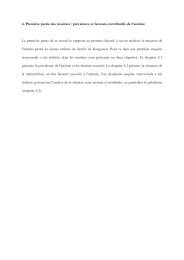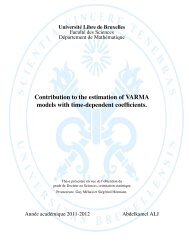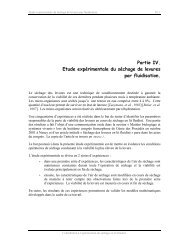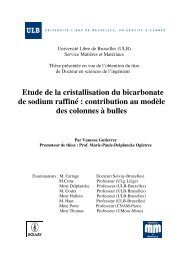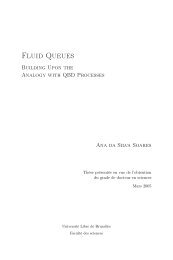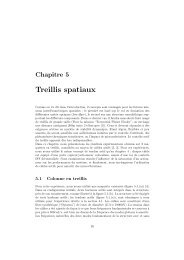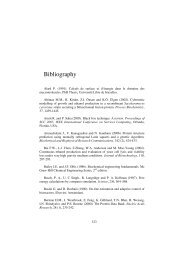Diagnostic partiel de la flore et de la végétation des Niayes et du ...
Diagnostic partiel de la flore et de la végétation des Niayes et du ...
Diagnostic partiel de la flore et de la végétation des Niayes et du ...
You also want an ePaper? Increase the reach of your titles
YUMPU automatically turns print PDFs into web optimized ePapers that Google loves.
Abstract<br />
Partial diagnosis of flora and veg<strong>et</strong>ation of <strong>Niayes</strong> and Peanut Basin areas in Senegal:<br />
application of floristic, phyotsociologic, <strong>et</strong>hnobotanic and mapping m<strong>et</strong>hods.<br />
Researches carried out in this thesis about updating flora and veg<strong>et</strong>ation data from two major<br />
agroecological regions of Senegal (<strong>Niayes</strong> and Peanut Basin) used vil<strong>la</strong>ge-scale based m<strong>et</strong>hodology in<br />
or<strong>de</strong>r to b<strong>et</strong>ter consi<strong>de</strong>r ligneous resources conservation. In savannas and sub-guinean veg<strong>et</strong>ations of<br />
respectively Peanut Basin and <strong>Niayes</strong>, 288 records were realized upon stratification m<strong>et</strong>hod based on<br />
<strong>et</strong>hnic groups (Wolof, Peul and Sérer), <strong>la</strong>nd use systems and topography in 6 vil<strong>la</strong>ges and 25 records in<br />
the reference sites. In these vil<strong>la</strong>ges, knowledge, priorisation and uses, prior to sustainable<br />
agrobiodiversity management, were also addressed on 124 ligneous species by <strong>et</strong>hnobotanic survey with<br />
216 respondants equally distributed to <strong>et</strong>hnic groups, ages and gen<strong>de</strong>r. Respondants also addressed<br />
veg<strong>et</strong>ation dynamics a long topographic position. Informations on <strong>la</strong>nd occupation trends were gained<br />
by air-photography cartography and Google earth 2006 image. Factorial experimentation on 3 factors<br />
(species, high and diam<strong>et</strong>er of sprouting) with 15 rep<strong>et</strong>itions was implemented on stump regeneration<br />
dynamics of the 2 principal Combr<strong>et</strong>aceae in the Peanut Basin region (Combr<strong>et</strong>um glutinosum and<br />
Guiera senegalensis). Multivariate and univariate analysis were performed on the data.<br />
Phytosociological results showed discrimination of 11 veg<strong>et</strong>ation groups (G). Two of them (G4 and G8)<br />
are savannas samples, one secondary forest (G10), two from semi-aquatic veg<strong>et</strong>ation (G1 and G5); in<br />
the other hand, two groups of disturbed situations (G6 and G7) and four cultivated and postcultural<br />
groups were found (G2, G3, G9 and G11). The first groups were progressively inva<strong>de</strong>d by cultural and<br />
poscultural species and the second groups by ru<strong>de</strong>rary and adventitious species. Systematic position of<br />
these groups was indicated. 336 species were recor<strong>de</strong>d: 260 in the <strong>Niayes</strong> and 176 in the Peanut Basin).<br />
Richness in wil<strong>de</strong>rness criterion was not always superior in peul vil<strong>la</strong>ges.<br />
Ethnobotanical results showed subdivision of species diversity in 4 c<strong>la</strong>sses of conservation priority.<br />
Most conservation priority species were multipurpose trees. A clear separation b<strong>et</strong>ween <strong>Niayes</strong> vil<strong>la</strong>ges<br />
and Peanut basin ones, and also b<strong>et</strong>ween counterparts’ vil<strong>la</strong>ges was found. Ethnobotanical valuation of<br />
species was higher in the Peanut Basin area. It grows with human <strong>de</strong>nsity a part from wolof vil<strong>la</strong>ge of<br />
the Peanut basin. Vil<strong>la</strong>ges of the Groundnut Basin showed no selectivity in the choice of species to me<strong>et</strong><br />
their different needs. This <strong>la</strong>ck of selectivity is compl<strong>et</strong>e and trans<strong>la</strong>tes woody resources scarcity.<br />
Cartographic results show an important <strong>la</strong>ndscape transformation in <strong>Niayes</strong> and Peanut basin areas <strong>du</strong>e<br />
to fields creation or aggregation processes running everywhere. This occurred against veg<strong>et</strong>ation<br />
formations : attrition of woody savanna in the two zones, attrition and aggregation of shrubby savanna<br />
in <strong>Niayes</strong> area, fragmentation and dissection in Peanut basin.<br />
In short term cutting system of the Peanut Basin, it should be b<strong>et</strong>ter to practise a selective logging<br />
m<strong>et</strong>hod according to species and diam<strong>et</strong>er c<strong>la</strong>sses in or<strong>de</strong>r to reconcile pro<strong>du</strong>ctivity and sustainability by<br />
ensuring stumps’ low-stem resprouting.<br />
An extension of terroir approach m<strong>et</strong>hodology in other local eco-geographical zones of Senegal should<br />
be tested in or<strong>de</strong>r to compl<strong>et</strong>e the i<strong>de</strong>ntification and monitoring of the dynamics of p<strong>la</strong>nt communities,<br />
their integration into mo<strong>de</strong>rn c<strong>la</strong>ssification to facilitate the monitoring of their spatio-temporal<br />
evolution. It should allow the assessment of species local importance variability.<br />
Keywords: Senegal, <strong>Niayes</strong>, Peanut-basin, flora, veg<strong>et</strong>ation groups, <strong>et</strong>hnobotany, spatial dynamics,<br />
forest experimentation.<br />
v



